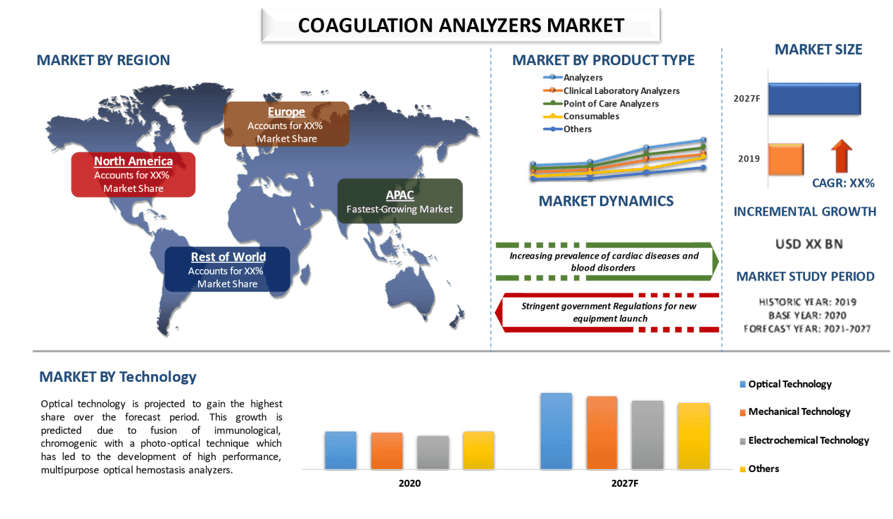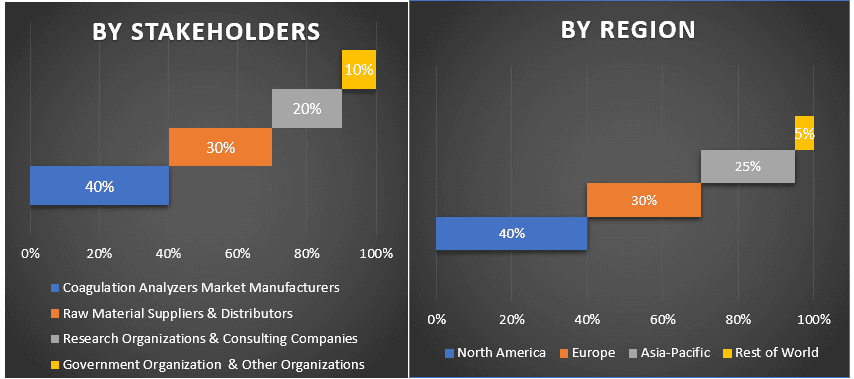
预计凝血分析仪市场在预测期内(2021-2027年)将呈现约XX%的复合年增长率。全球凝血分析仪市场预计将实现强劲增长,这主要是由于心脏病和血液疾病(如血栓栓塞性疾病)以及出血性疾病(如肝功能受损、血友病和血管性血友病)的患病率不断上升。此外,更先进的分析仪的可用性增加,人们对这些疾病及其管理的认识不断提高,以及老年人口基数的增加,这些因素都可能在预测期内推动全球凝血分析仪市场的发展。此外,主要市场参与者研发支出的增加以及他们对新设备和仪器的推出和批准的关注,预计将进一步推动市场增长。
目前全球范围内的COVID-19疫情对社会的不同方面产生了巨大的影响,凝血分析仪市场也不例外。由于批量需求的转移,凝血分析仪市场受到了积极的影响,医院和诊所的就诊人数大幅增加。因此,众多行业的产品销售和供应链都受到了积极的影响,特别是在2020年的前两个季度。由于需求量大和普遍的财务困境,这对凝血分析仪产品的贸易产生了不利影响。
报告中呈现的见解
“在测试类型中,凝血酶原时间测试领域在2020年占据市场主导地位”
根据测试类型,凝血分析仪市场分为凝血酶原时间测试、纤维蛋白原测试、激活凝血时间测试、激活部分凝血活酶时间测试、d-二聚体测试、血小板功能测试和其他凝血测试。2020年,凝血酶原时间测试类别占据市场主导地位。这主要是由于全球老年人口不断增加,加上不健康的生活方式和荷尔蒙失衡。
“在最终用户中,诊断中心类别将见证最快的增长速度”
根据最终用户,市场分为医院和诊所、诊断中心、研究机构和其他机构。2020年,诊断中心类别在全球市场中占据了多数份额。此外,具有更高精度和可执行多项测试功能的先进设备的可用性是增长的另一个重要驱动因素。例如,根据经济合作与发展组织(OECD)的数据,美国政府在医疗保健方面的支出从人均8032.6美元增加到2019年的人均9386.5美元。此外,医院完善的基础设施、更好的报销政策、先进技术的可用性以及训练有素的医疗保健专业人员也是患者选择医院和诊所进行伤口护理的主要原因之一。
“北美将在预测期内主导市场”
为了更好地了解凝血分析仪市场的需求,对包括北美(美国、加拿大、北美其他地区);欧洲(德国、英国、法国、意大利、欧洲其他地区);亚太地区(中国、印度、日本、澳大利亚、亚太其他地区)和世界其他地区在内的主要地区进行了市场分析。目前,北美在2020年主导市场;然而,由于中国、印度和其他亚洲发展中国家医疗保健支出的增加,预计亚太地区将见证最高的复合年增长率。市场上运营的一些主要参与者包括雅培公司、丹纳赫、西门子医疗有限公司、希森美康株式会社、赛默飞世尔科技公司、F. Hoffmann-La Roche Ltd.、HORIBA Medical、日本光电株式会社、迈克生物股份有限公司、Bio-Group Medical System。
购买本报告的理由:
- 该研究包括经过认证的主要行业专家验证的市场规模和预测分析
- 该报告提供了一览无余的整体行业绩效快速回顾
- 该报告对主要的行业同行进行了深入分析,主要关注关键的业务财务、产品组合、扩张策略和最新发展
- 详细考察了行业中存在的驱动因素、限制因素、关键趋势和机遇
- 该研究全面涵盖了不同细分市场的市场
- 深入分析行业区域层面的分析
定制选项:
凝血分析仪市场可以根据要求或任何其他市场细分进行进一步定制。除此之外,UMI理解您可能拥有自己的业务需求,因此请随时与我们联系以获取完全符合您要求的报告。
目录
分析历史市场、评估当前市场以及预测凝血分析仪市场的未来,是创建和分析全球主要地区凝血分析仪需求和销售额的三个主要步骤。我们进行了详尽的二级研究,以收集历史市场数据并评估当前市场规模。其次,为了验证这些见解,我们考虑了大量的发现和假设。此外,我们与行业价值链上的行业专家进行了广泛的一级访谈。在通过一级访谈对市场数据进行假设和验证后,我们采用了自下而上的方法来预测完整的市场规模。此后,我们采用了市场细分和数据三角剖分方法来评估和分析行业相关细分市场和子细分市场的市场规模。详细的方法如下所述。
历史市场规模分析
第一步:深入研究二级来源:
我们进行了详细的二级研究,通过公司内部来源(如年度报告和财务报表、业绩演示、新闻稿等)以及外部来源(包括期刊、新闻和文章、政府出版物、竞争对手出版物、行业报告、第三方数据库和其他可信出版物)来获取凝血分析仪的历史市场规模。
第二步:市场细分:
在获得凝血分析仪的历史市场规模后,我们进行了详细的二级分析,以收集主要地区不同细分市场和子细分市场的历史市场见解和份额。报告中包含的主要细分市场包括产品类型、测试类型、技术、最终用户和地区。此外,我们进行了区域层面的分析,以评估全球范围内凝血分析仪的总体需求。
第三步:因素分析:
在获得不同细分市场和子细分市场的历史市场规模后,我们进行了详细的因素分析,以评估当前的市场规模。此外,我们使用依赖性和独立性变量(如行业趋势、产品应用、了解消费者需求、竞争格局、品牌定位和定价分析)进行因素分析。我们分析了历史趋势及其对市场规模和份额的逐年影响。还彻底研究了需求和供应方的情况。
当前市场规模评估和预测
当前市场规模评估:基于以上3个步骤的可行见解,我们得出了当前的市场规模、市场中的主要参与者以及细分市场和公司的市场份额。所有需要的百分比拆分和市场细分都使用上述二级方法确定,并通过一级访谈进行验证。
评估和预测:对于市场评估和预测,我们为不同的因素分配了权重,包括驱动因素和趋势、限制因素以及利益相关者可获得的机会。在分析了这些因素之后,我们应用了相关的预测技术,即自下而上的方法,得出到2027年全球主要地区不同细分市场和子细分市场的市场预测。用于评估市场规模的研究方法包括:
- 行业的市场规模,按价值(美元)和全球主要地区对凝血分析仪的需求计算
- 所有市场细分和子细分的百分比份额、拆分和细分
- 凝血分析仪市场中主要参与者提供的产品。此外,这些参与者为在快速增长的市场中竞争而采取的增长策略。
市场规模和份额验证
一级研究:我们与主要意见领袖 (KOL) 进行了深入访谈,包括主要国家/地区的高层管理人员(CXO/VPs、销售主管、市场主管、运营主管以及区域主管、国家主管等)。然后总结一级研究结果,并进行统计分析以证明所述假设。一级研究的输入与二级研究结果合并,从而将信息转化为可操作的见解。
不同地区一级参与者的划分

市场工程
我们采用数据三角剖分技术来完成整体市场评估,并得出凝血分析仪市场每个细分市场和子细分市场的精确统计数字。在研究了产品类型、测试类型、技术、最终用户和地区等领域的各种参数和趋势之后,数据被分成几个细分市场和子细分市场。
凝血分析仪市场研究的主要目标
研究指出了凝血分析仪市场的当前和未来市场趋势。投资者可以从研究中进行的定性和定量分析中获得战略见解,以作为其投资判断的依据。当前和未来的市场趋势将决定市场在区域层面的总体吸引力,为行业参与者提供一个利用未开发市场以受益于先行者优势的平台。研究的其他定量目标包括:
- 分析凝血分析仪的当前和预测市场规模(按价值(美元)计算)。此外,分析行业不同细分市场和子细分市场的当前和预测市场规模
- 研究中的细分市场包括产品类型、测试类型、技术、最终用户和地区
- 明确定义的凝血分析仪行业监管框架分析
- 分析涉及各种中介机构的价值链,以及分析与该行业相关的客户和竞争对手行为
- 分析全球凝血分析仪的当前和预测市场规模。报告中分析的主要地区包括北美(美国、加拿大、北美其他地区);欧洲(德国、英国、法国、意大利、欧洲其他地区);亚太地区(中国、印度、日本、澳大利亚、亚太其他地区);以及世界其他地区。定义和分析凝血分析仪行业的竞争格局,以及市场参与者为在快速增长的市场中保持竞争力而采取的增长策略
深入分析行业的区域层面
相关 报告
购买此商品的客户也购买了










